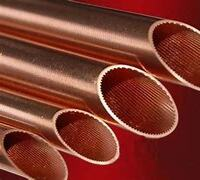1. Introduction
Just 36 hours ago, a massive data center in Northern Virginia experienced a near-catastrophic power surge during a summer thunderstorm—but stayed online, thanks to its grounding system built around high-conductivity copper earth rods. Meanwhile, in the North Sea, a new offshore wind turbine array was commissioned using copper bonded ground rods driven deep into the seabed to protect against lightning and corrosion. These aren’t your grandpa’s plumbing supplies. Copper rod—often dismissed as a commodity—is quietly enabling some of the most advanced engineering feats of our time.

Forget the cliché of copper pipes hissing in old radiators. Today’s copper rod comes in forms like copper brazing rod, copper to copper welding rod, and even flexible copper bus bar—all engineered for precision, conductivity, and resilience. Whether it’s a 1mm copper strip stabilizing a satellite’s thermal system or a copper clad steel earth rod anchoring a 5G tower in the desert, copper remains the metal of choice when performance trumps price.
2. Earthing That Won’t Quit: Copper Rods Beneath Our Feet
Grounding isn’t glamorous, but it’s the silent guardian of every electrical system on Earth. And when engineers need reliability, they reach for the copper earth rod—or more precisely, the copper bonded earthing rod. Unlike pure copper rods (which can be costly), copper bonded ground rods fuse a thick layer of electrolytic copper over high-tensile steel, delivering 90% of copper’s conductivity at half the price. The result? A copper clad steel ground rod that drives deep, resists corrosion for decades, and won’t buckle under stress.
In high-salinity environments—like coastal telecom stations or offshore platforms—these copper clad earth rods outperform alternatives by miles. And while you might search for ‘earthing rod price’ online, savvy buyers know that a slightly higher upfront cost for copper bonded steel pays off in longevity. After all, replacing a failed ground rod underwater isn’t just expensive—it’s nearly impossible.
3. The Art (and Science) of Joining Copper: Brazing and Welding Rods

Ever tried welding copper? It’s like trying to nail jelly to a wall—unless you’ve got the right copper rod for welding. Enter copper brazing rod and copper to copper brazing rods, specially formulated to flow smoothly into joints without cracking or oxidizing. These aren’t your hardware-store leftovers; they’re precision alloys often containing phosphorus or silver to lower melting points and boost capillary action.
In aerospace and HVAC manufacturing, copper rod welding is critical for assembling aircon copper tubes that must withstand extreme pressure and temperature swings. A poorly brazed joint in an air conditioning copper pipe could mean refrigerant leaks—or worse, system failure mid-summer. That’s why technicians swear by copper welding rod designed specifically for copper-to-copper applications. It’s not just about joining metal; it’s about creating a seamless, monolithic conductor.
4. Beyond Rods: Flat Copper Strips and the Hidden Wiring Revolution
While rods get the spotlight, flat copper strips are the unsung heroes of modern electronics and power distribution. Need a copper strip for earthing in a substation? Check. Building a flexible copper bus bar for an EV battery pack? Done. Even gardeners use copper tape for snails (yes, really—it gives them a mild shock that deters them without harm).

The market for copper strip is booming, with variants like beryllium copper strip for springs, nickel plated copper strip for RF shielding, and thin copper strips for flexible circuits. Recycling centers are flooded with people stripping copper wire for scrap, but the real value lies in knowing the best way to strip copper cable without damaging the metal—because burned or nicked copper fetches far less at the yard. Pro tip: skip the open flame (burning copper wire for scrap releases toxic fumes) and use a mechanical stripper instead.
And if you’re sourcing materials, terms like ‘copper earth strip 25x3mm price’ or ‘copper strip near me’ matter—because specs dictate performance. A 1mm copper strip in a drone’s power bus handles current differently than a thick copper metal strip in a transformer. Precision isn’t optional; it’s existential.
5. From Round Bars to Ingots: The Bigger Picture
Don’t overlook the humble copper round bar—or round bar copper, as suppliers call it. Used in machining, electrical contacts, and even art fabrication, these solid bars are the raw material for custom components. Paired with copper ingots and cu bars, they form the backbone of industrial metal supply chains. And while copper bar top countertops might be trendy in Brooklyn lofts, engineers care more about conductivity specs and tensile strength.
Even in the age of fiber optics and silicon chips, copper remains irreplaceable. Why? Because electrons still move faster and cleaner through copper than through almost anything else. Whether it’s a 22mm copper pipe feeding coolant to a server rack or a copper strip roll feeding an automated assembly line, the metal’s legacy is far from over.
6. Conclusion
Copper rod isn’t just a relic of the Industrial Age—it’s a high-performance material evolving with our tech-driven world. From copper bonded steel earthing rods guarding renewable energy infrastructure to copper brazing rods sealing the veins of modern HVAC systems, this metal proves that sometimes, the oldest solutions are still the smartest. So next time you hear ‘copper rod,’ think less ‘plumber’s toolbox’ and more ‘unsung enabler of the digital age.’
Our Website founded on October 17, 2012, is a high-tech enterprise committed to the research and development, production, processing, sales and technical services of ceramic relative materials such as Copper. Our products includes but not limited to Boron Carbide Ceramic Products, Boron Nitride Ceramic Products, Silicon Carbide Ceramic Products, Silicon Nitride Ceramic Products, Zirconium Dioxide Ceramic Products, etc. If you are interested, please feel free to contact us.

